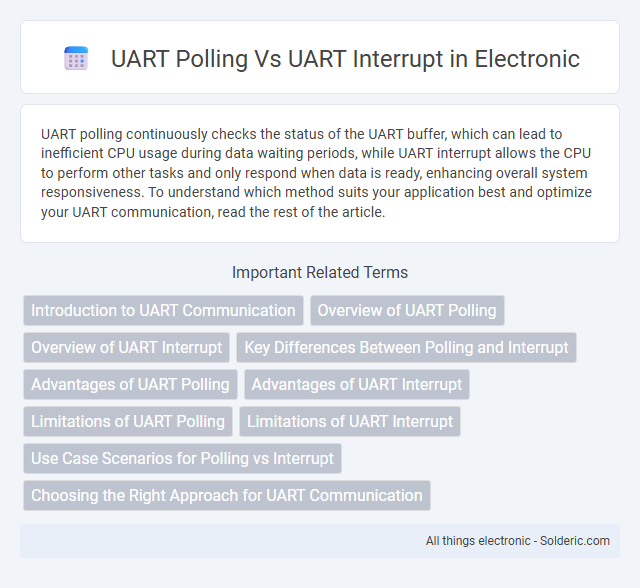UART polling continuously checks the status of the UART buffer, which can lead to inefficient CPU usage during data waiting periods, while UART interrupt allows the CPU to perform other tasks and only respond when data is ready, enhancing overall system responsiveness. To understand which method suits your application best and optimize your UART communication, read the rest of the article.
Comparison Table
| Feature | UART Polling | UART Interrupt |
|---|---|---|
| Definition | CPU actively checks UART status repeatedly. | CPU responds to UART events via interrupts. |
| CPU Usage | High, wastes cycles in busy-wait. | Low, CPU executes other tasks until interrupt. |
| Latency | Potentially higher, depends on polling rate. | Lower, immediate response to UART events. |
| Complexity | Simple to implement. | More complex, requires interrupt handling. |
| Power Efficiency | Lower, continuous CPU activity. | Higher, CPU sleeps or works on other tasks. |
| Data Throughput | Limited by polling frequency. | Higher, handles data as it arrives. |
| Use Case | Simple or low-speed communication. | High-speed or multitasking environments. |
Introduction to UART Communication
UART communication transfers data serially between devices using transmit (TX) and receive (RX) lines, crucial for embedded systems. UART polling continuously checks the status of the UART hardware for data readiness, leading to CPU resource inefficiency. In contrast, UART interrupt triggers the CPU only when data is received or ready to send, optimizing your system's responsiveness and resource management.
Overview of UART Polling
UART polling involves continuously checking the status of the UART data register to determine if data has been received or if the transmit buffer is ready. This method is simple to implement but can lead to inefficient CPU usage as it requires constant monitoring, which may stall other tasks. Your system's performance can be affected if polling is used in high-speed or multitasking environments, making UART interrupts a more efficient choice for handling data asynchronously.
Overview of UART Interrupt
UART interrupt enables efficient data handling by signaling the processor only when new data arrives or transmission is complete, reducing CPU idle time compared to UART polling. This method enhances system performance in embedded applications by allowing the CPU to execute other tasks until an interrupt triggers, improving multitasking and responsiveness. UART interrupt-driven communication is crucial for real-time systems requiring low-latency data processing and minimal processor overhead.
Key Differences Between Polling and Interrupt
UART polling continuously checks the status of the UART data register, consuming CPU resources and potentially causing inefficient processing during idle times. UART interrupt triggers the CPU only when data is ready, allowing your system to perform other tasks concurrently and improving overall efficiency. Key differences include CPU utilization, response time, and resource management, with interrupts generally preferred for real-time applications requiring timely data handling.
Advantages of UART Polling
UART polling offers straightforward implementation and control, enabling the microcontroller to actively check the status of the UART data register without relying on interrupt handling. This method provides predictable timing for data processing in systems with low data rates or where timing precision is not critical. UART polling reduces the complexity of software development by avoiding interrupt service routines and potential race conditions.
Advantages of UART Interrupt
UART interrupt offers significant advantages over polling by enabling efficient CPU usage, allowing your system to perform other tasks while waiting for data reception or transmission. It reduces latency by immediately responding to incoming data without constant status checking, enhancing real-time performance. This approach also lowers power consumption, particularly beneficial in embedded and battery-powered devices.
Limitations of UART Polling
UART polling suffers from inefficiency by continuously checking the status of the UART flag, which wastes CPU resources and increases power consumption. It can lead to missed data or slower processing speed when the CPU is busy with other tasks because polling requires your processor to be actively involved in monitoring. This method is unsuitable for high-speed or real-time communication systems where rapid and reliable data handling is critical.
Limitations of UART Interrupt
UART interrupt handling offers efficient data processing by responding only when data is available, but it has limitations including increased complexity in firmware design and the risk of interrupt overload causing missed data during high traffic. Interrupt latency and priority management can introduce timing uncertainties, compromising real-time performance in critical applications. Understanding these limitations helps you optimize UART communication for stable and reliable data transfer.
Use Case Scenarios for Polling vs Interrupt
UART polling is ideal for simple applications where data transfer is infrequent or timing is non-critical, such as basic sensor readouts or small microcontroller projects. UART interrupt suits scenarios requiring efficient CPU utilization and timely response, including high-speed data communication or multitasking embedded systems. Your choice depends on balancing system complexity, performance needs, and power consumption.
Choosing the Right Approach for UART Communication
Choosing the right approach for UART communication depends on application requirements such as responsiveness and CPU efficiency. UART polling continuously checks the status register, providing simplicity but consuming more CPU cycles, making it suitable for low data rates or non-critical timing. UART interrupt enables asynchronous data handling by triggering an interrupt upon data receipt, improving CPU utilization and responsiveness in systems with higher data rates or multitasking environments.
UART polling vs UART interrupt Infographic

 solderic.com
solderic.com